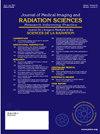评估真空锁装置在下肢经皮腔内血管成形术中固定患者的作用
IF 1.3
Q3 RADIOLOGY, NUCLEAR MEDICINE & MEDICAL IMAGING
Journal of Medical Imaging and Radiation Sciences
Pub Date : 2024-10-01
DOI:10.1016/j.jmir.2024.101507
引用次数: 0
摘要
在经皮经腔血管成形术中,患者不合作的动作会导致手术时间延迟,并造成不必要的辐射照射。因此,在本研究中,我们尝试将通常用于放射治疗的真空锁装置应用于介入放射科患者,以研究其实用性。本研究设立了三个实验组。首先,在猪脚上使用了光学刺激发光剂量计,以确定使用真空锁装置时辐射照射剂量的变化。其次,对于双腿都接受手术的患者,只在一侧使用真空锁定装置,而不在另一侧使用。之后,对拍摄的图像进行比较。第三,对于只在一条腿上接受手术的患者,在经皮腔内血管成形术前使用疫苗锁定装置,并在球囊扩张完成后移除该装置。我们比较了使用真空锁定装置前后的图像。使用真空锁定装置后,与未使用真空锁定装置的病例相比,平均核心剂量增加了 0.24 mSv,表面剂量增加了 0.29 mSv。为了证明使用真空锁定装置会抑制患者运动的假设,对 20 名患者进行了研究。结果显示,20 名患者中有 14 名在使用真空锁定装置前后出现了差异。研究发现,真空锁定装置对运动抑制有显著效果。本文章由计算机程序翻译,如有差异,请以英文原文为准。
Evaluation of the usefulness of Vacuum-lock device for patient immobilization during lower extremity percutaneous transluminal angioplasty
During Percutaneous trans-luminal angioplasty, the patient's uncooperative movements cause delays in the procedure time, and unnecessary radiation exposure. Therefore, in this study, we attempted to investigate the usefulness of the vaccum-lock device, which is usually used in radiation therapy, by applying it to interventional radiology patients. Three experimental groups were set up for this study. First, an Optical stimulated luminescense dosimeter was used on pig feet to determine the radiation exposure dose that changes when the vaccum-lock device is applied. Second, for patients who received the procedure on both legs, the vaccum-lock device was applied only to one side and NOT to the other side. Afterwards, the captured images were compared. Third, in the case of a patient who received the procedure on only one leg, the vaccum-lock device was applied before percutaneous transluminal angioplasty, and the device was removed after ballooning was completed. We compared the images before and after applyung the device.When vacuum-lock deivce was applied, the average core dose increased by 0.24 mSv compared to the case without it, and the surface dose increased by 0.29 mSv.
As a result of examining the difference in radiation exposure due to the application of vacuum-lock device, it was found that there was no significant difference in the deep dose and shallow dose that the patient received due to the application of the vacuum-lock device. A study was conducted on 20 patients to prove the hypothesis that the patient's movements would be inhibited by applying the Vacuum-Lock Device. As a result, 14 of the 20 patients studied showed differences before and after applying the Vacuum-Lock Device. It was found that there was a significant effect on movement inhibition.
求助全文
通过发布文献求助,成功后即可免费获取论文全文。
去求助
来源期刊

Journal of Medical Imaging and Radiation Sciences
RADIOLOGY, NUCLEAR MEDICINE & MEDICAL IMAGING-
CiteScore
2.30
自引率
11.10%
发文量
231
审稿时长
53 days
期刊介绍:
Journal of Medical Imaging and Radiation Sciences is the official peer-reviewed journal of the Canadian Association of Medical Radiation Technologists. This journal is published four times a year and is circulated to approximately 11,000 medical radiation technologists, libraries and radiology departments throughout Canada, the United States and overseas. The Journal publishes articles on recent research, new technology and techniques, professional practices, technologists viewpoints as well as relevant book reviews.
 求助内容:
求助内容: 应助结果提醒方式:
应助结果提醒方式:


